Cookbook #250: Two Hundred Toasts, Mlle. Mixer, New York City, Osborn Printing Co., Los Angeles, Ca, 1905.
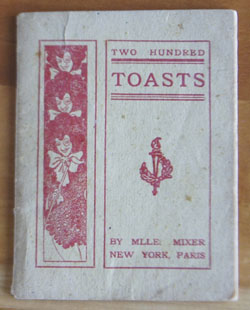
Let’s toast! To life, love, and the end of this “250 Cookbooks” blog! I began this section of my cooking blog back in October 2012 – here is my introduction. Now it’s June 2018. It’s been a long journey.
Two Hundred Toasts is the oldest of my “cookbooks”. It is actually a book of “toasts”, as in words said with the clinking of glasses. But I entered it in the database, and here we are.
1905. This book is 113 years old today. Is it worth a lot of money? A search revealed that I could purchase other publication years (1906 and 1917) for just $50. It is worth a lot more than that to me. It belonged to my grandmother – my mother’s mother – and I can remember many, many family dinners that began with a toast. And ended with one of Grandmother’s fantastic desserts. She always said “I only eat dinner to get dessert”, although she never gained weight, and she also enjoyed her cocktails. And her sherry, but that’s another story. My mother grew up on their large orange grove ranch in Southern California, where she ran free and loved her horse and went to school in Covina. Her older brother was friends with my father, they all went to school together, and that’s how my parents met and eventually fell in love and married and had the three of us.
I’m going to do something a little different with Two Hundred Toasts. There are no recipes in this book, so I have no recipe to cook. But the book is a delight, so I’ll scan in all the pages for us all to enjoy.
Here are the title and facing pages.
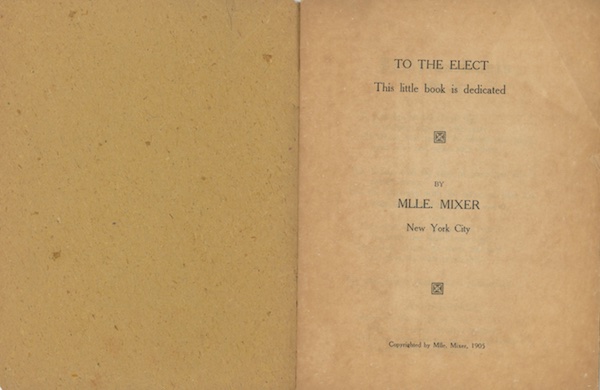
Next comes the first page of toasts, “Parisian Tosts”. Oops, a misspell. The first of many, I find. Mlle. Mixer is French (the front cover says “New York, Paris) so English must be her second language, or she was a bad typist. Google Books has digitized the 1906 version of this book. It’s different from my 1905 edition: all of the misspellings have been corrected. My edition is sort of endearing, typos and all. No spell checkers in 1905!
This size of scan makes it hard for us to read. I’ll leave the following one “as is” because I want to illustrate the facing page with the “Osborn Printing Co.” on it. But after these first two pages, I’ll scan them in as half-pages.

My favorite of the above toasts? The last, especially the line “Till your little shoes and my big boots are under the bed together”.
Here’s the next page. I like “When a man says he has a wife, he menas [sic] that a wife has him.”
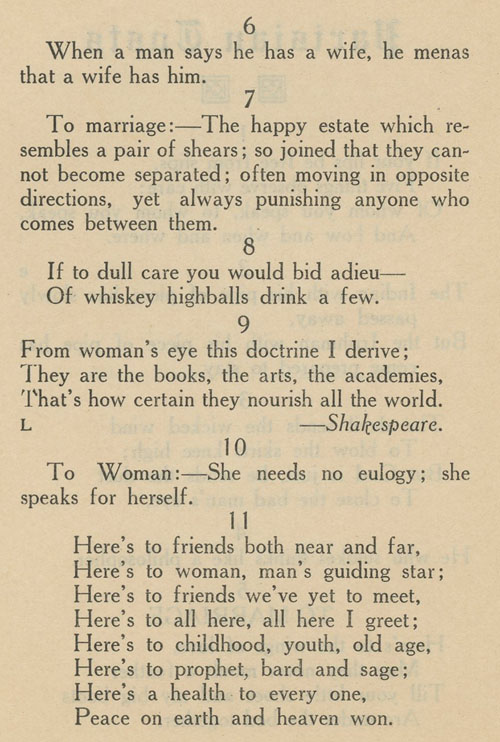
“Since man is dust, it would appear, ‘Twere well to water him with beer.”
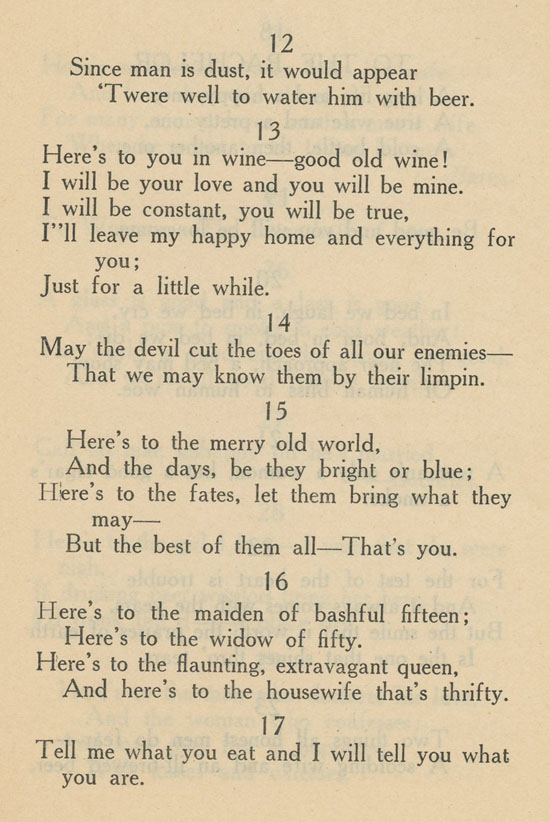 “Be good and you will be lonesome.”
“Be good and you will be lonesome.”
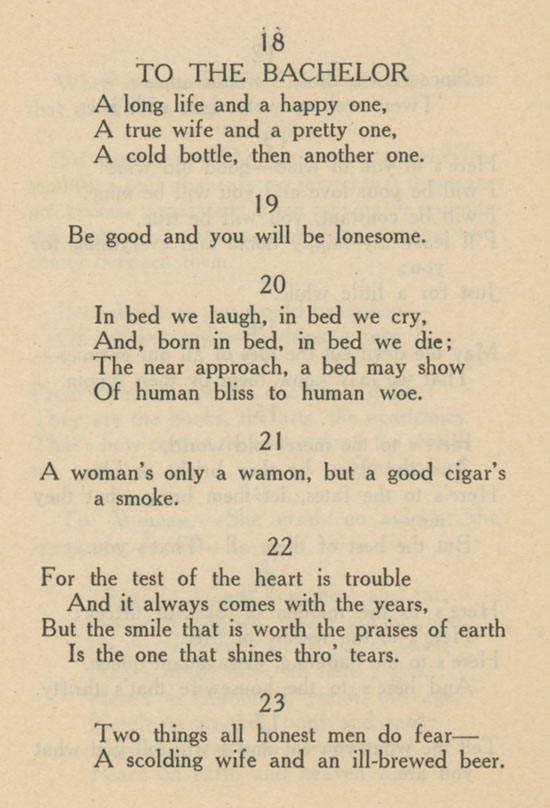 Oh my! Such an attitude: “To Woman: the bitter half of man” and “Call no man unhappy till he’s married.”
Oh my! Such an attitude: “To Woman: the bitter half of man” and “Call no man unhappy till he’s married.”
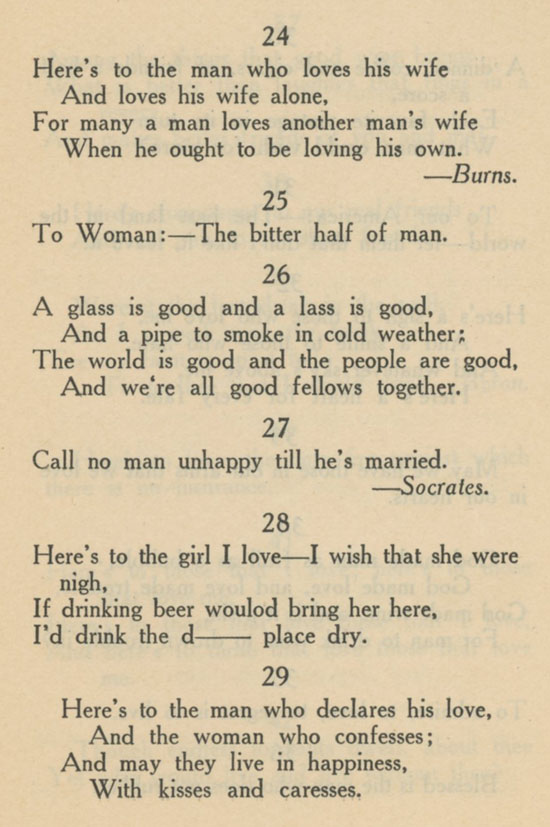 “To our America: The best land in the world – let them that don’t like it, leave it.”
“To our America: The best land in the world – let them that don’t like it, leave it.”
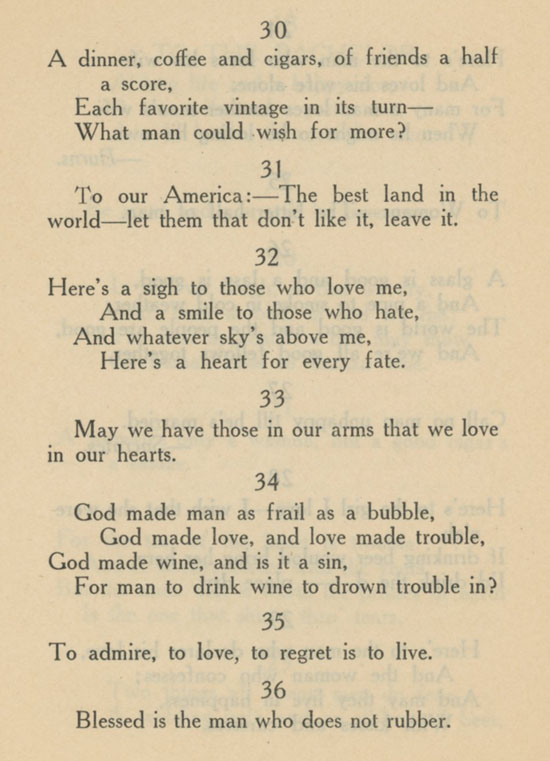 “Among the things that good wine brings, what is better than laughter that rings in a revery and makes better friends of you and me!” I like the one about champagne too.
“Among the things that good wine brings, what is better than laughter that rings in a revery and makes better friends of you and me!” I like the one about champagne too.
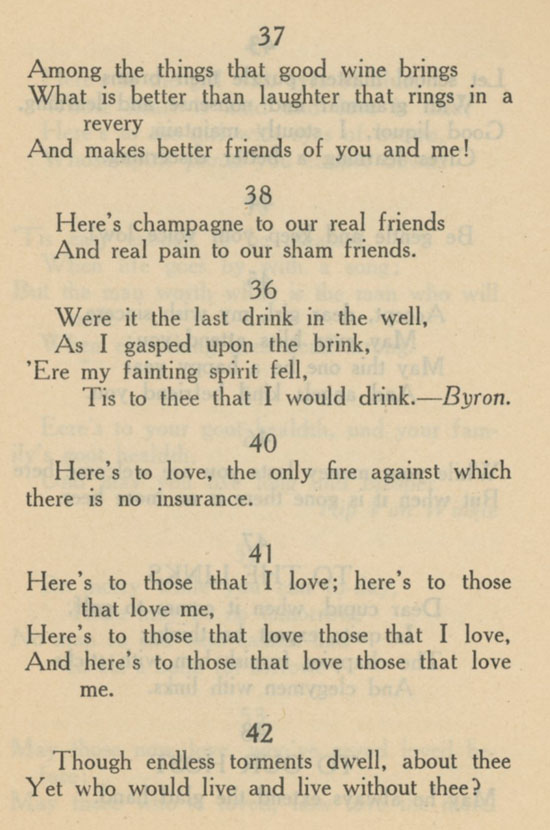 “Good liquor, I stoutly maintain, gives learning a better discerning!”
“Good liquor, I stoutly maintain, gives learning a better discerning!”
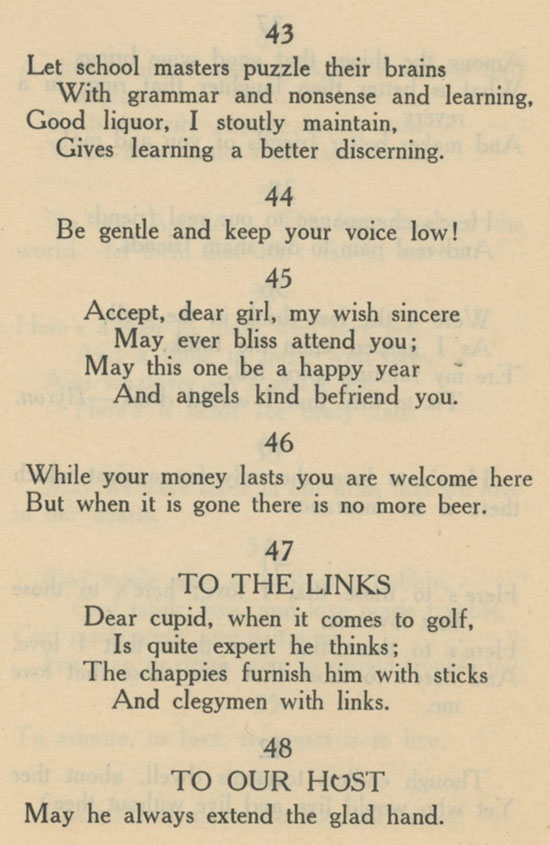 “Tis easy enough to be pleasant, when life goes by with a song; but the man worth while is the man who will smile when everything goes dead wrong.”
“Tis easy enough to be pleasant, when life goes by with a song; but the man worth while is the man who will smile when everything goes dead wrong.”
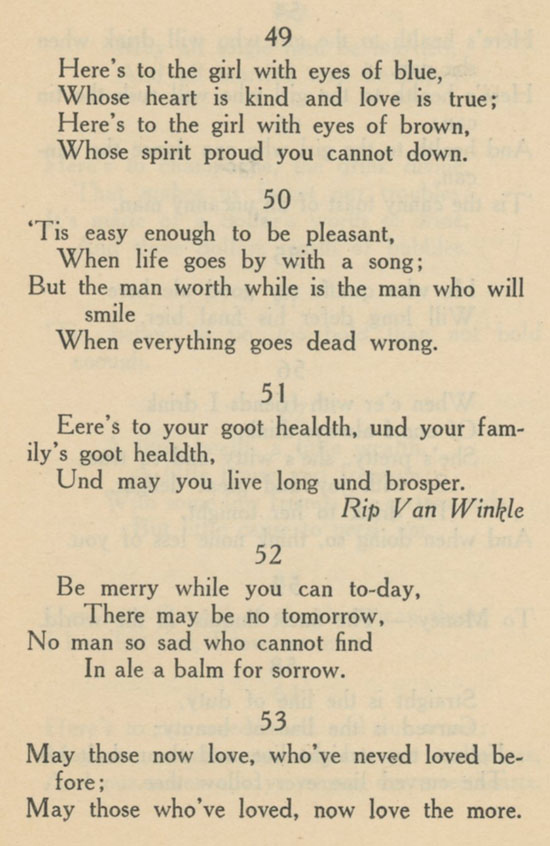 “Here’s health to the girl who will drink when she can, and health to the girl who can dance the can-can.”
“Here’s health to the girl who will drink when she can, and health to the girl who can dance the can-can.”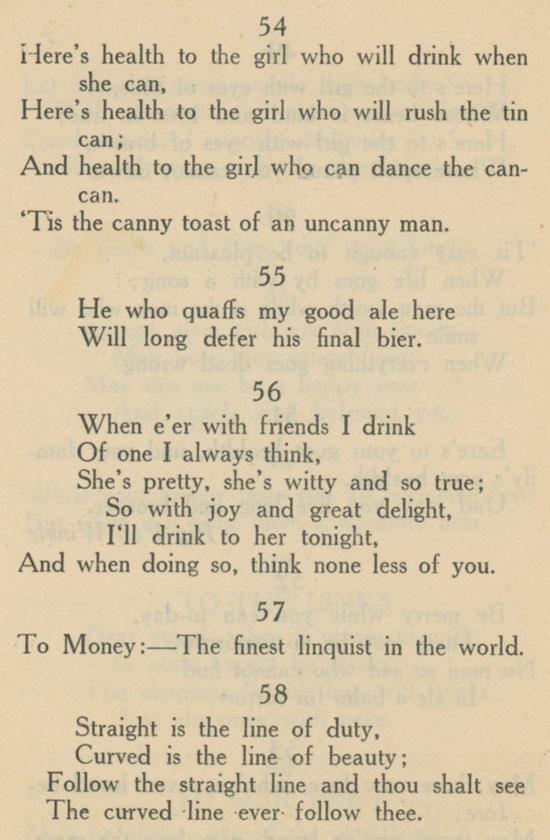 “Here’s to champagne, the drink divine, that makes us forget our troubles; it’s made of a dollar’s worth of wine, and three dollars worth of bubbles.”
“Here’s to champagne, the drink divine, that makes us forget our troubles; it’s made of a dollar’s worth of wine, and three dollars worth of bubbles.”
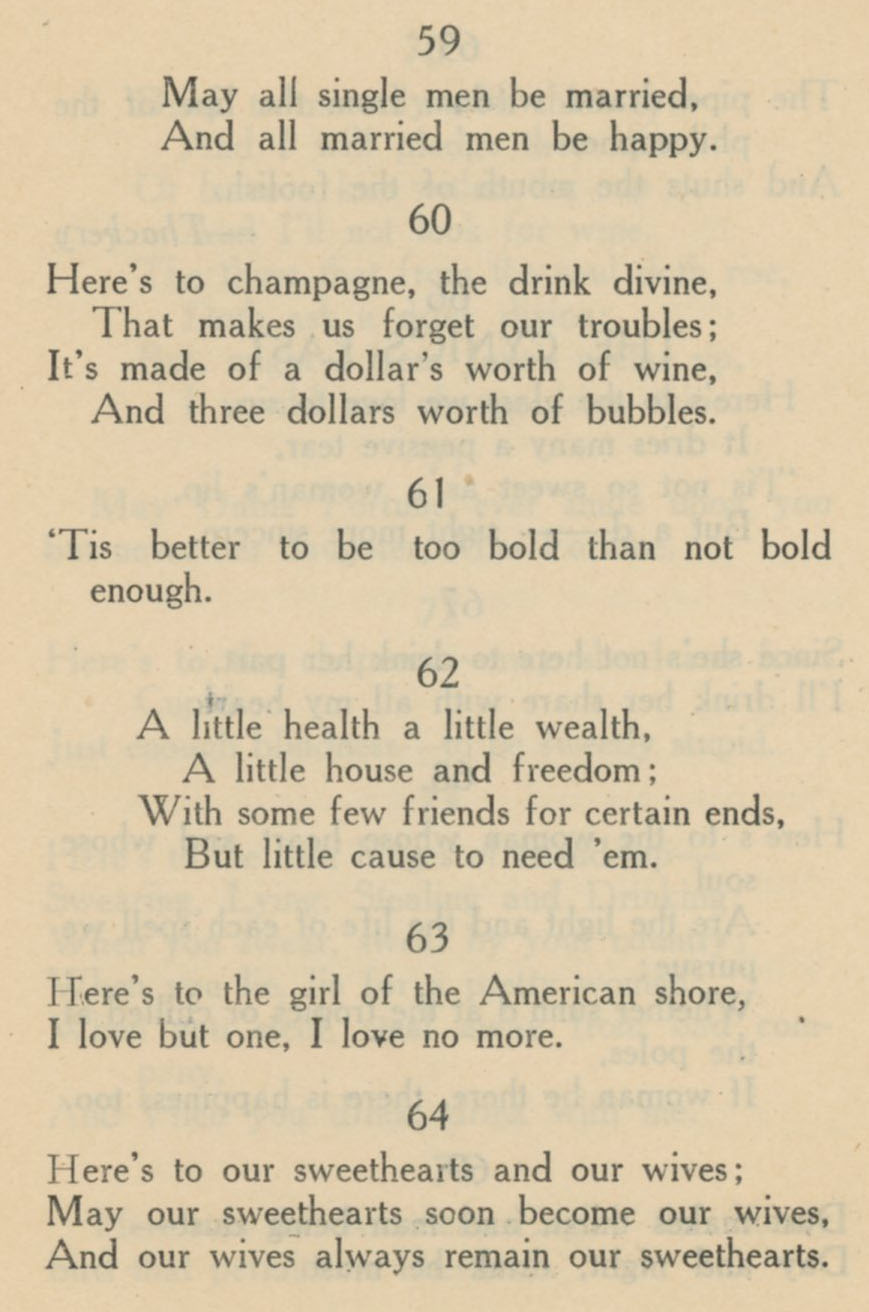 “Since she’s not here to drink her part, I’ll drink her share with all my heart.”
“Since she’s not here to drink her part, I’ll drink her share with all my heart.” “May Dame Fortune ever smile upon you but never her daughter, Miss fortune.” And also: “Here’s to the chaperone – may she learn from Cupid. Just enough blindness – to be sweetly stupid.”
“May Dame Fortune ever smile upon you but never her daughter, Miss fortune.” And also: “Here’s to the chaperone – may she learn from Cupid. Just enough blindness – to be sweetly stupid.”
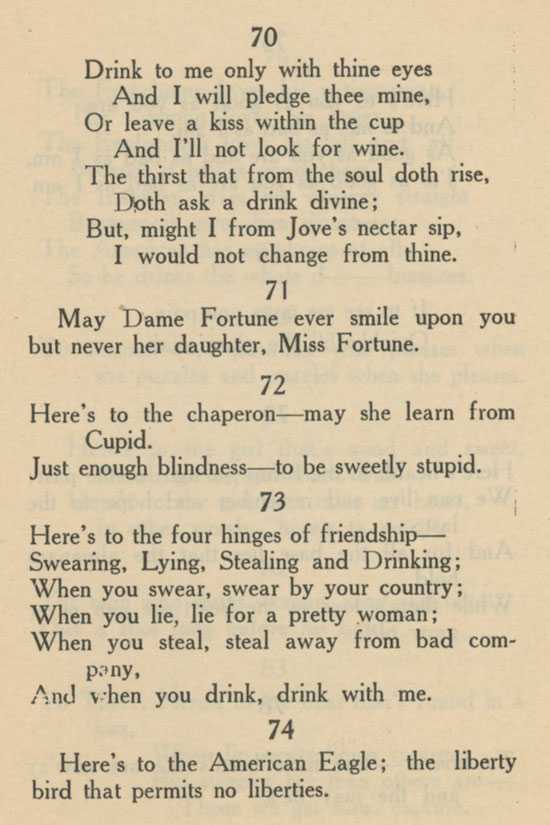
“To Home: – The place we are treated best and grumble most.”
Number 88 is a racial slur, but I guess it wasn’t in 1905. We might not have come a long way here in America, but at least we have come a little ways.
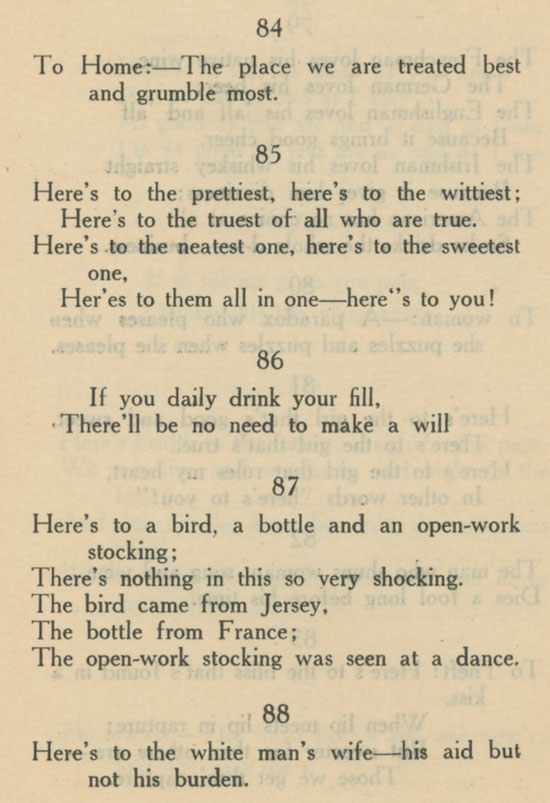
“Here’s to the light that lies in a woman’s eyes; And lies! And lies! And lies!”
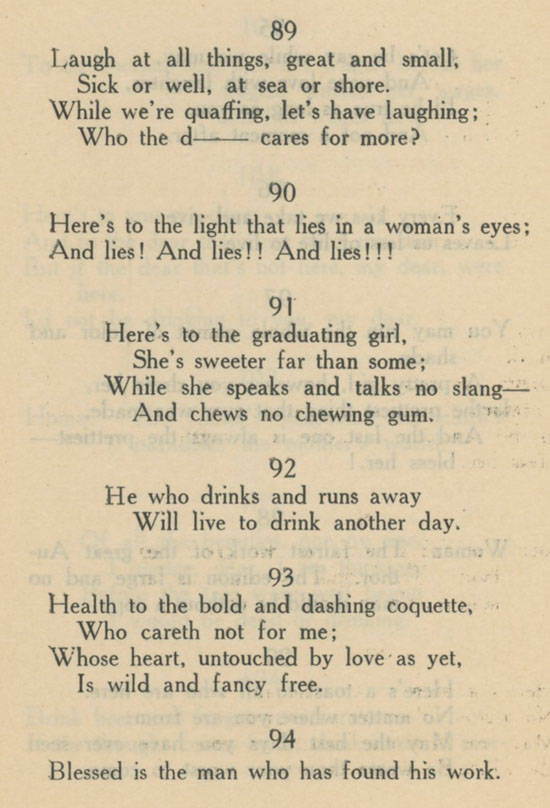
“Woman: The fairest work of the great Author. The edition is large and no man should be without a copy.” And “May the best days you have ever seen be worse than your worst to come.”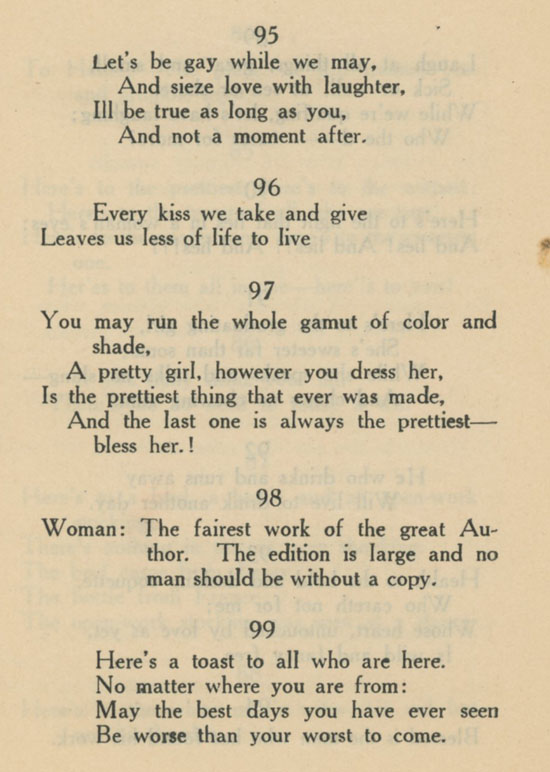 “Drink beer and forget your sorrow; if the thought comes back, drink more to morrow.” I also like number 100, about the servant and her wages.
“Drink beer and forget your sorrow; if the thought comes back, drink more to morrow.” I also like number 100, about the servant and her wages.
 “While beer brings gladness, don’t forget that water only makes you wet.”
“While beer brings gladness, don’t forget that water only makes you wet.”
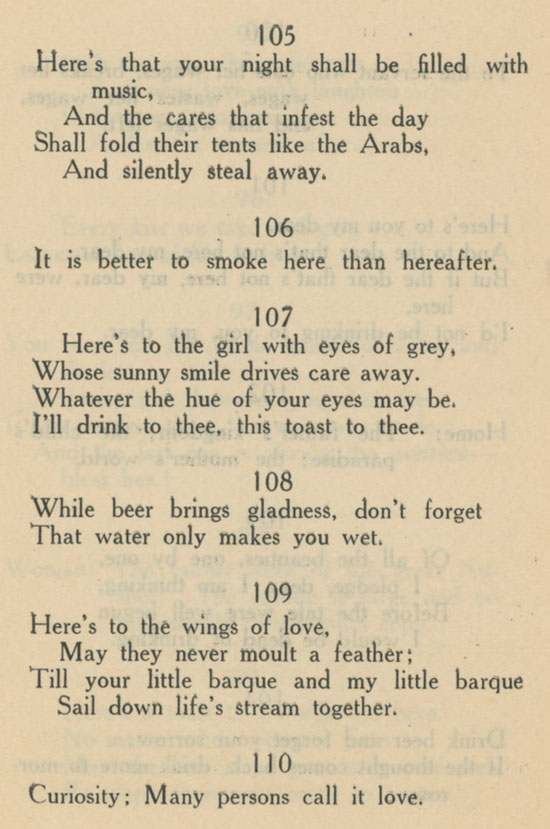 “The health of those we love best – ourselves.”
“The health of those we love best – ourselves.”
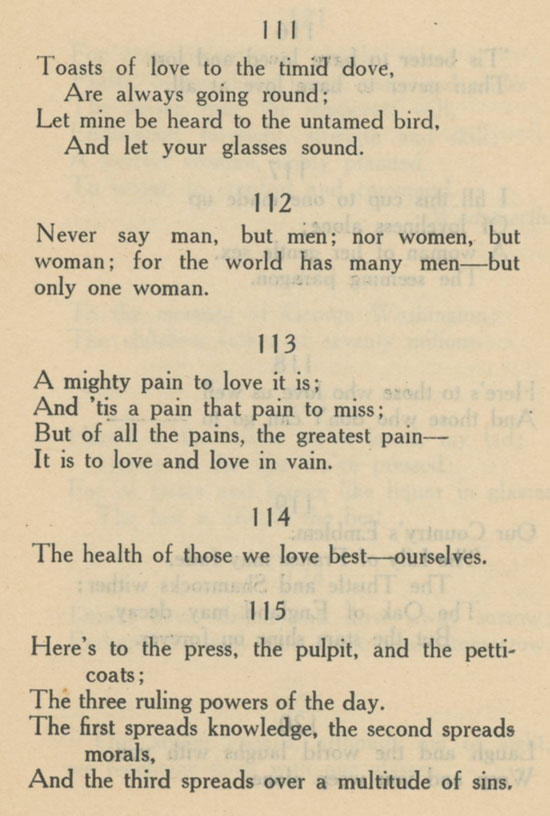 The classic: “Tis better to have loved and lost than never to have love at all.”
The classic: “Tis better to have loved and lost than never to have love at all.”
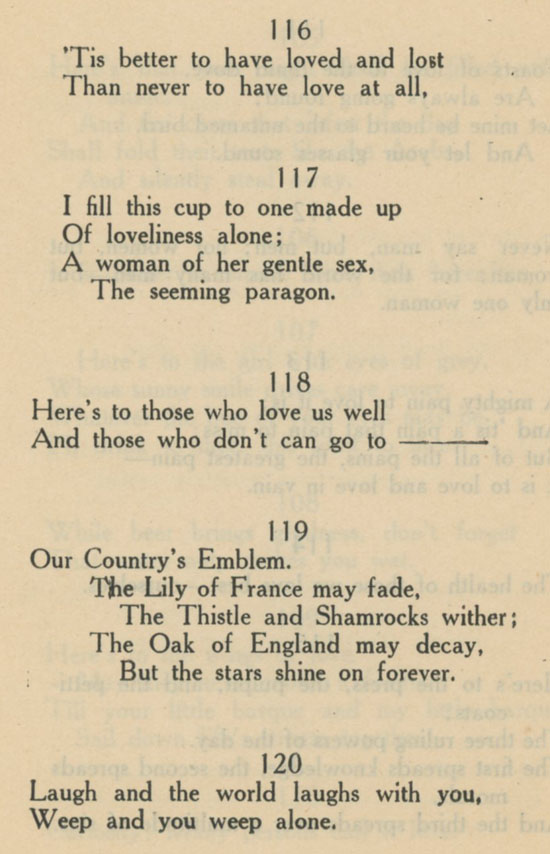 “Our absent friends, although out of sight, we recognize them with our glasses.”
“Our absent friends, although out of sight, we recognize them with our glasses.”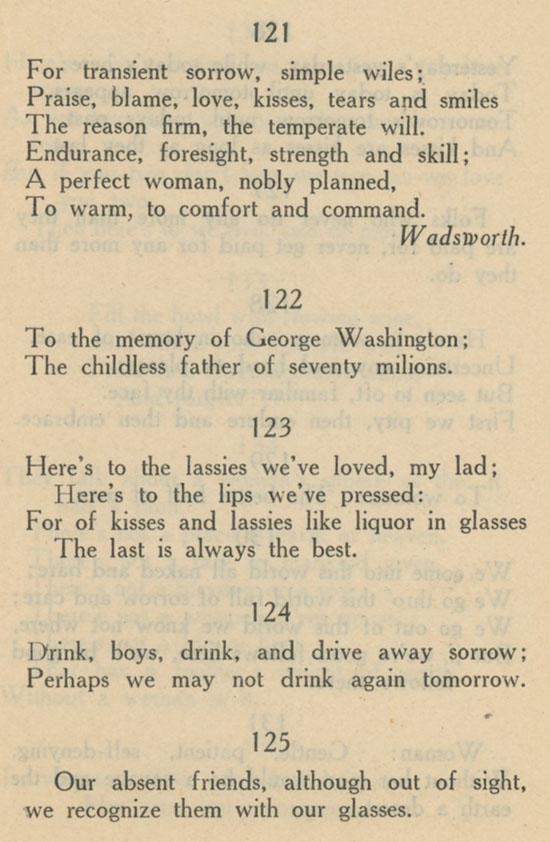 “Woman: Gentle, patient, self-denying. Without her man would be a savage and the earth a desert.”
“Woman: Gentle, patient, self-denying. Without her man would be a savage and the earth a desert.”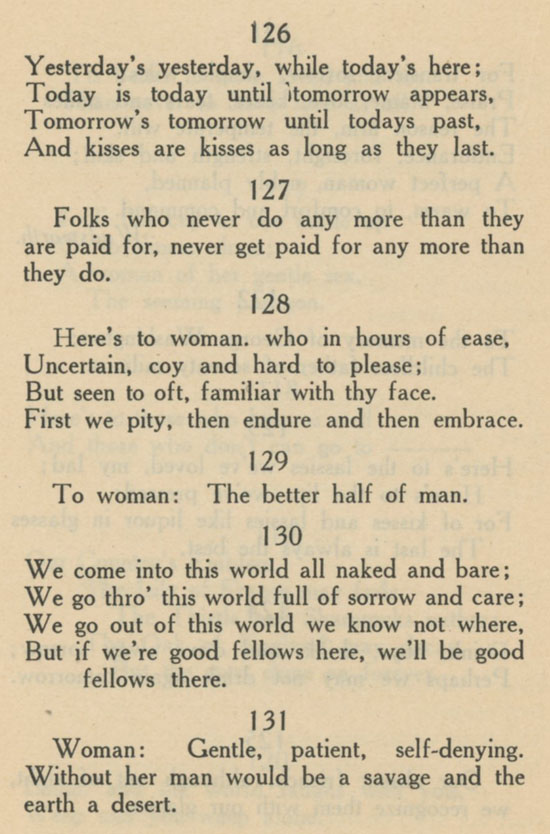 “Fill the bowl with flowing wine, and while your lips are wet, press their fragrance unto mine, and forget!!!!”
“Fill the bowl with flowing wine, and while your lips are wet, press their fragrance unto mine, and forget!!!!”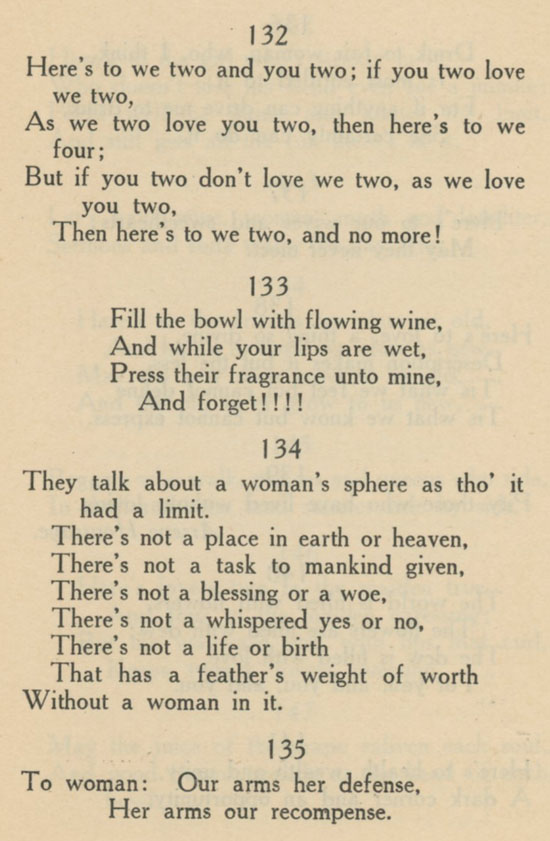 “Here’s to our wives and sweethearts; may they never meet.”
“Here’s to our wives and sweethearts; may they never meet.”
 “Let’s have wine, women, mirth and laughter, sermons and soda water the day after.”
“Let’s have wine, women, mirth and laughter, sermons and soda water the day after.”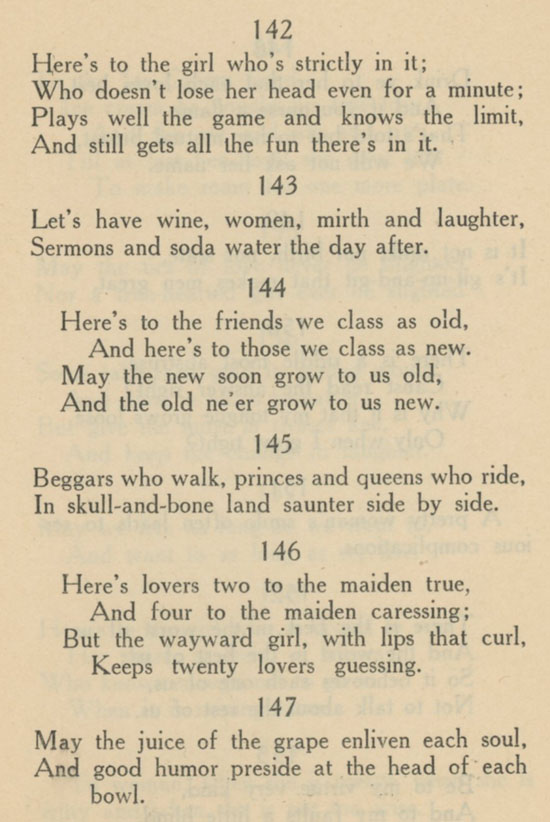
“It is not rank, nor birth, nor state, it’s git-up-and-git that makes men great.”
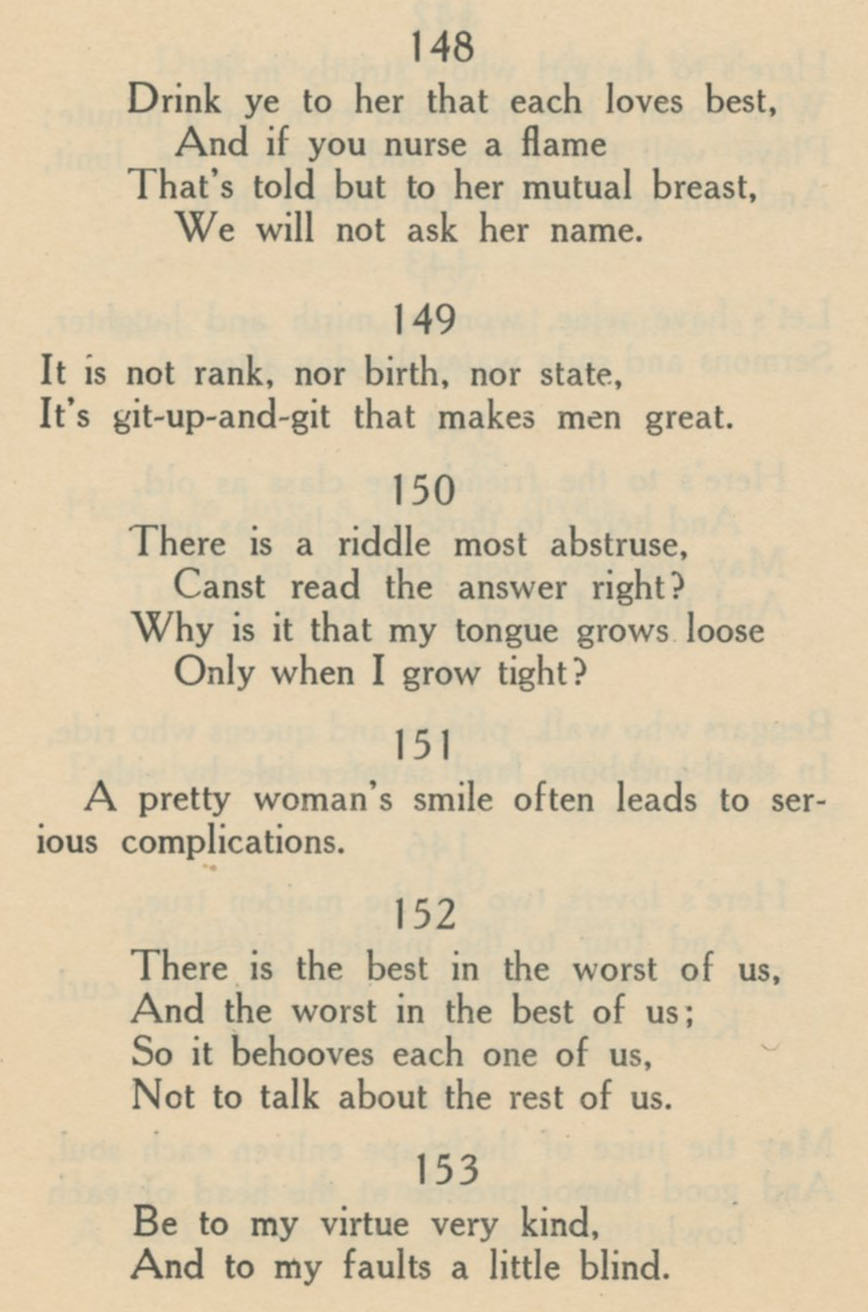 May we live as long as we want to, and want to as long as we live.”
May we live as long as we want to, and want to as long as we live.”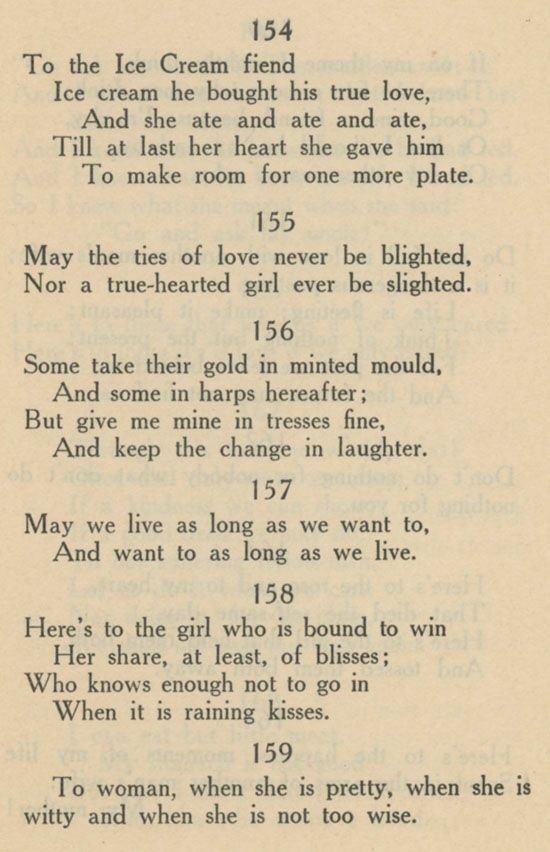 “Don’t do nothing for nobody what don’t do nothing for you.”
“Don’t do nothing for nobody what don’t do nothing for you.”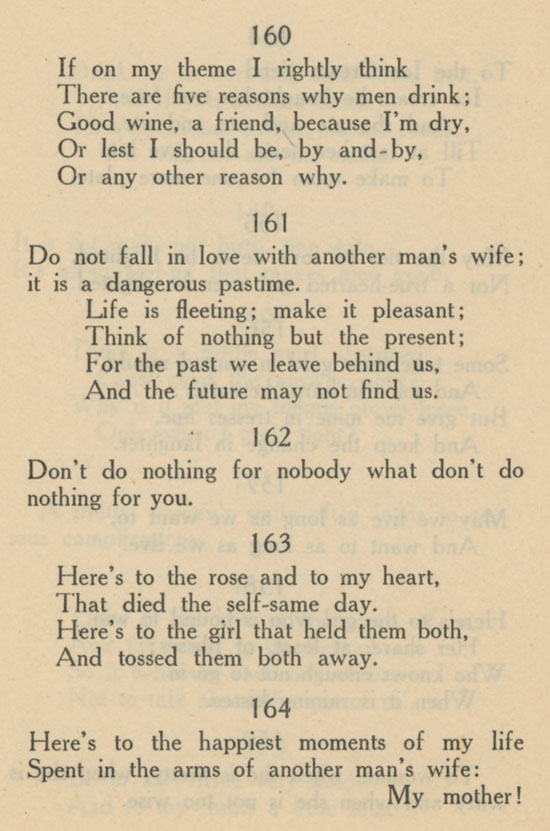 I like number 167, that ends: “We shall not pass this way again.”
I like number 167, that ends: “We shall not pass this way again.”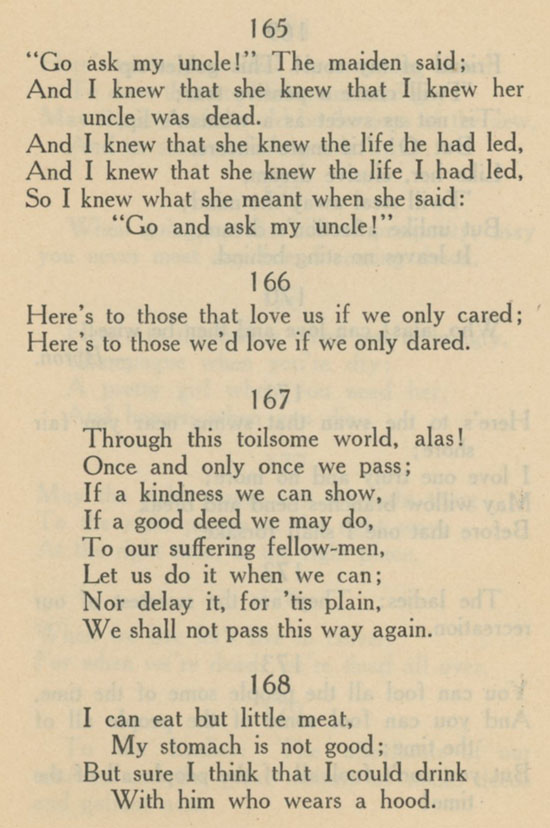 “You can fool all the people some of the time, and you can fool some of the people all of the time; but you can’t fool all of the people all of the time!”
“You can fool all the people some of the time, and you can fool some of the people all of the time; but you can’t fool all of the people all of the time!”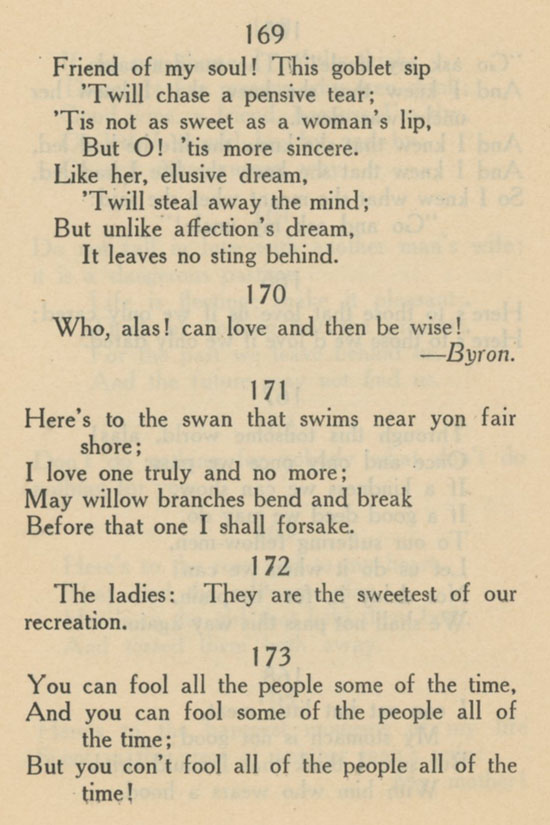 “When going up the hill of prosperity, may you never meet any friend coming down.”
“When going up the hill of prosperity, may you never meet any friend coming down.”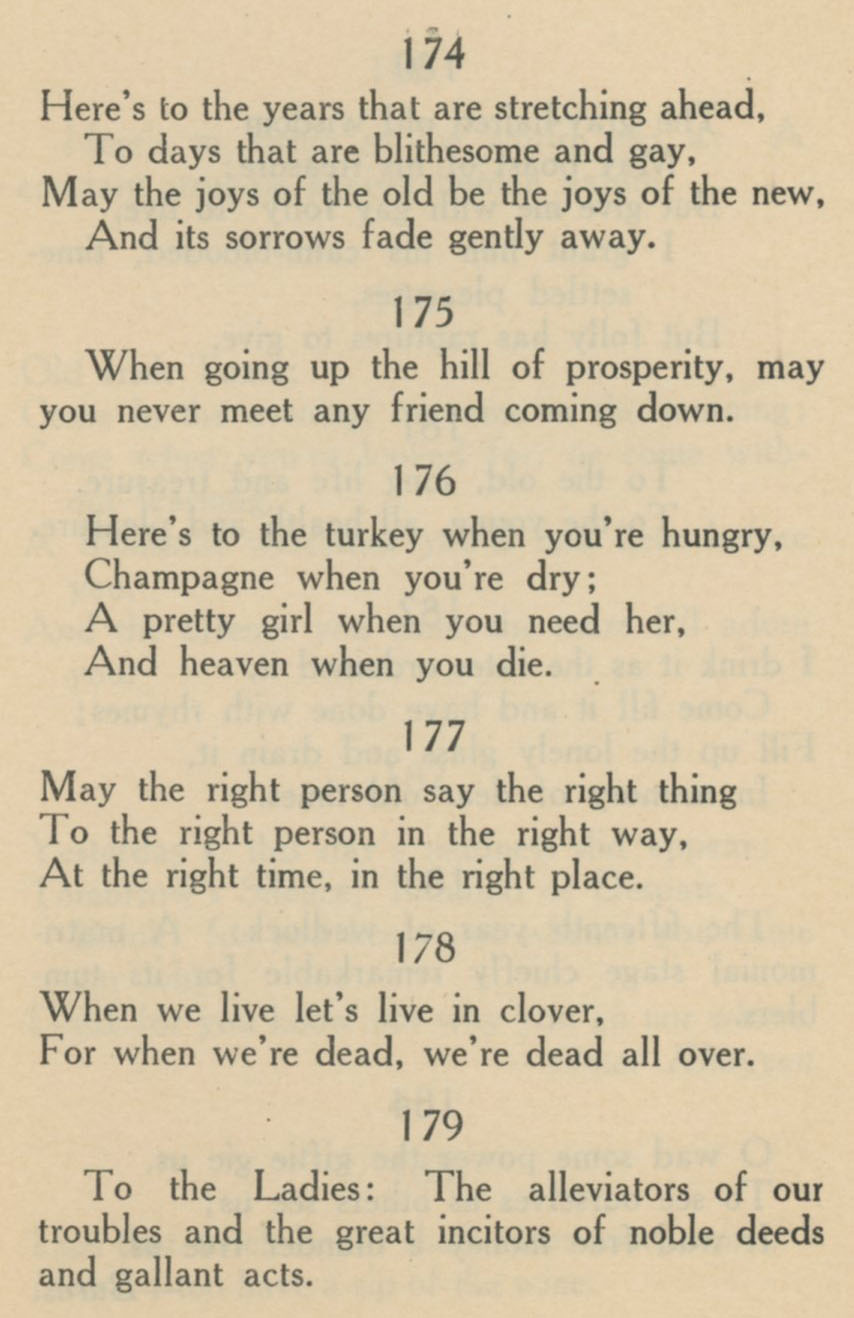 “To the old, long life and treasure. To the young, all health and pleasure.”
“To the old, long life and treasure. To the young, all health and pleasure.”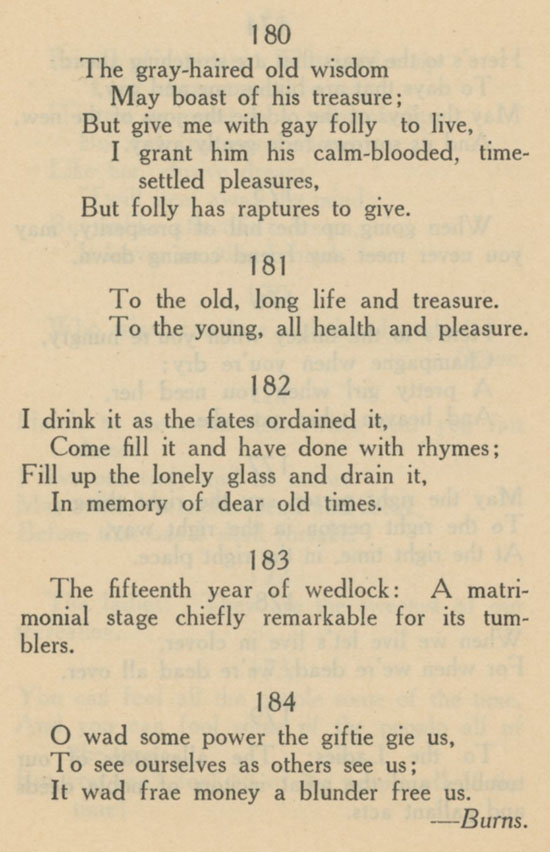 “Here’s to virtue as the world sees it: A constant struggle against human nature.” And “Lips that touch liquor shall never touch mine, unless I too have a sip of the wine.”
“Here’s to virtue as the world sees it: A constant struggle against human nature.” And “Lips that touch liquor shall never touch mine, unless I too have a sip of the wine.”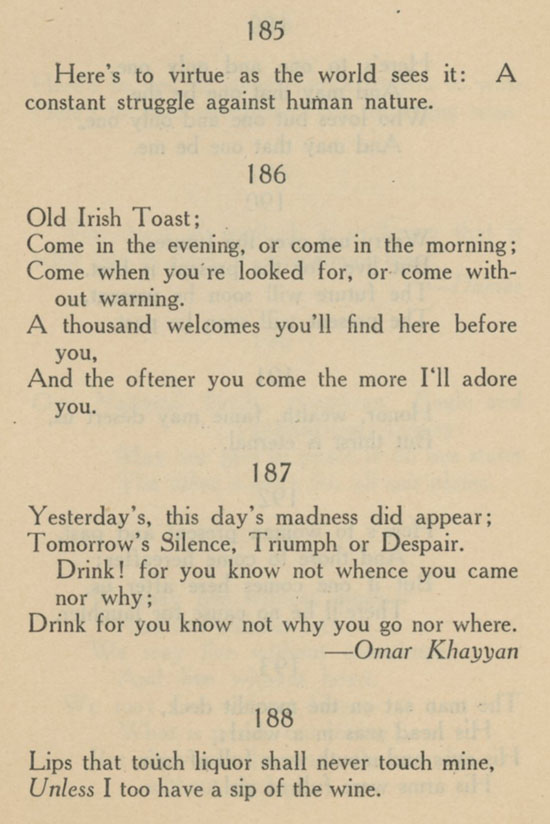 “Honor, wealth, fame may desert us, but thirst is eternal.”
“Honor, wealth, fame may desert us, but thirst is eternal.”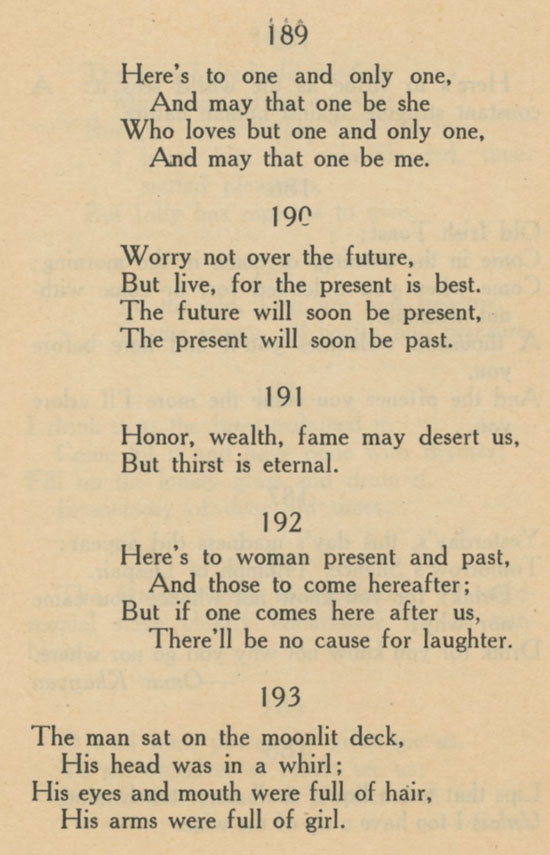 “Here’s to you in water, here’s to you in wine, here’s to your sweetheart, not forgetting mine.”
“Here’s to you in water, here’s to you in wine, here’s to your sweetheart, not forgetting mine.”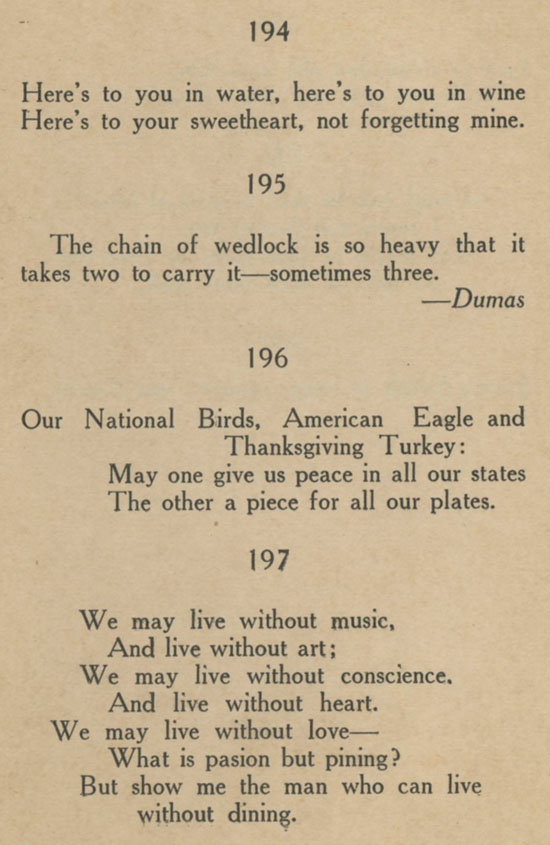 “Love is sweet, but oh! how bitter to love a girl, and then not git her.”
“Love is sweet, but oh! how bitter to love a girl, and then not git her.” And so we come to the end of Two Hundred Toasts by Mlle. Mixer. I hope you found a few toasts that you liked.
And so we come to the end of Two Hundred Toasts by Mlle. Mixer. I hope you found a few toasts that you liked.

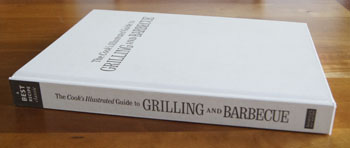 My second-to-last cookbook in this 250 Cookbooks blog! Hard to believe this 5-year project is coming to an end.
My second-to-last cookbook in this 250 Cookbooks blog! Hard to believe this 5-year project is coming to an end.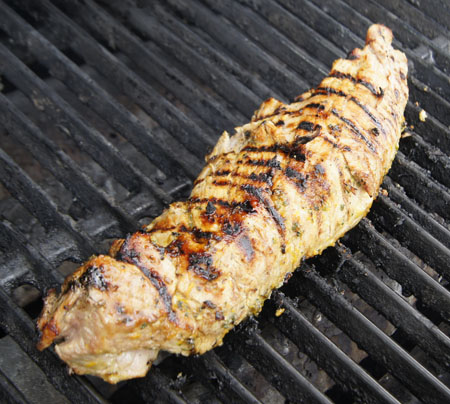 Yum! This was perfect! Moist and flavorful with great grill marks. I served it with a green salad and corn on the cob for a light, healthy, tasty meal.
Yum! This was perfect! Moist and flavorful with great grill marks. I served it with a green salad and corn on the cob for a light, healthy, tasty meal. Pillsbury’s Bake Off Dessert Cook Book is the last and grandest of my Pillsbury Bake-Off cookbooks. All of the others are small booklets but this one is hard-cover bound and 144 pages long. It includes recipes from “Eighteen years of Pillsbury Bake Offs”, updated with “short-cuts and the use of convenience food ingredients where possible”. (I discuss Pillsbury Bake-off cookbooks/recipe magazines more thoroughly in my blog post covering the
Pillsbury’s Bake Off Dessert Cook Book is the last and grandest of my Pillsbury Bake-Off cookbooks. All of the others are small booklets but this one is hard-cover bound and 144 pages long. It includes recipes from “Eighteen years of Pillsbury Bake Offs”, updated with “short-cuts and the use of convenience food ingredients where possible”. (I discuss Pillsbury Bake-off cookbooks/recipe magazines more thoroughly in my blog post covering the 
 These were excellent. Except for the crust, they aren’t terribly rich. The next night, I made another batch of the cherry mixture and served them with ice cream. Yum!
These were excellent. Except for the crust, they aren’t terribly rich. The next night, I made another batch of the cherry mixture and served them with ice cream. Yum!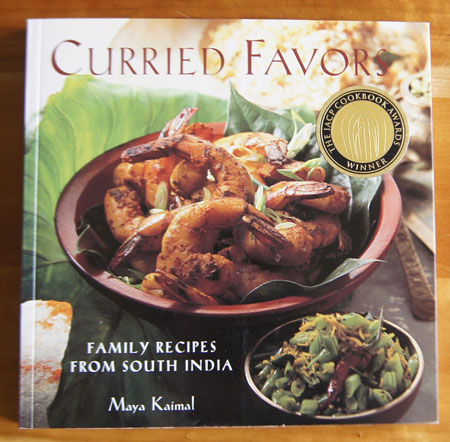
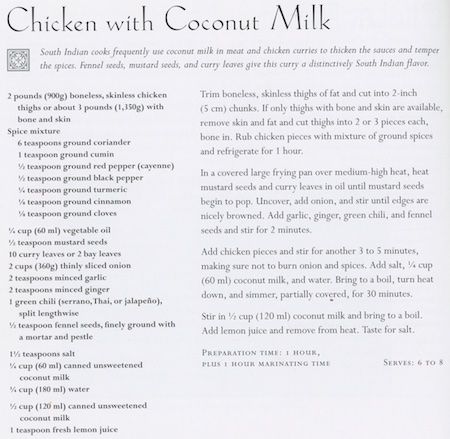 I plan to cut the recipe in half and leave out the turmeric, and use less cayenne. I have everything for this recipe in my pantry and or my freezer except the coconut milk and a fresh hot chili (a quick trip to a store solved those issues). I will use bay leaves instead of curry (or kari) leaves. (I know where to find curry leaves in downtown Boulder, but don’t have any in my pantry right now.} I also increased the amount of coconut milk. Below is my adaptation of the above recipe.
I plan to cut the recipe in half and leave out the turmeric, and use less cayenne. I have everything for this recipe in my pantry and or my freezer except the coconut milk and a fresh hot chili (a quick trip to a store solved those issues). I will use bay leaves instead of curry (or kari) leaves. (I know where to find curry leaves in downtown Boulder, but don’t have any in my pantry right now.} I also increased the amount of coconut milk. Below is my adaptation of the above recipe. When the chicken has rested in its rub (refrigerated) for at least an hour, set a frying pan on medium high heat and add the oil, mustard seeds, and bay leaf. Cover. Heat until the mustard seeds pop. Uncover and add the onion and cook and stir until the onion is browning nicely. Add the garlic, ginger, green chili, and ground fennel seeds and cook and stir for 2 minutes.
When the chicken has rested in its rub (refrigerated) for at least an hour, set a frying pan on medium high heat and add the oil, mustard seeds, and bay leaf. Cover. Heat until the mustard seeds pop. Uncover and add the onion and cook and stir until the onion is browning nicely. Add the garlic, ginger, green chili, and ground fennel seeds and cook and stir for 2 minutes.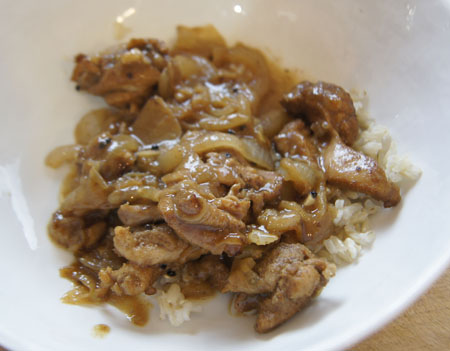 I love this curry. I like the whole cooking process, too. The aromas as it cooks! The flavors as I eat it! But hubby? Well, he ate it all. But when asked, he said something like “yeah, it was dinner”. Guess I didn’t slip this curry by him. Maybe it isn’t just the yellow color that he does not like about curries. His loss.
I love this curry. I like the whole cooking process, too. The aromas as it cooks! The flavors as I eat it! But hubby? Well, he ate it all. But when asked, he said something like “yeah, it was dinner”. Guess I didn’t slip this curry by him. Maybe it isn’t just the yellow color that he does not like about curries. His loss.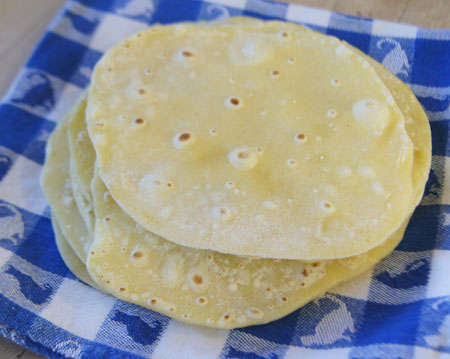 I also made chappathi from another recipe in this book. These are small flatbreads cooked on a stove-top, similar to tortillas, but made from durum wheat flour (“atta” flour) and water (and a little salt) – that’s all. I had some durum wheat flour in my pantry because of forays into pasta cooking. To make the chappathi, you mix and knead together flour and water, cut into equal-sized pieces, roll each to a circle, and cook briefly on a hot griddle. It’s kind of like making tortillas or crepes or pita breads. Mine came out pretty good. Here’s the rolled out dough:
I also made chappathi from another recipe in this book. These are small flatbreads cooked on a stove-top, similar to tortillas, but made from durum wheat flour (“atta” flour) and water (and a little salt) – that’s all. I had some durum wheat flour in my pantry because of forays into pasta cooking. To make the chappathi, you mix and knead together flour and water, cut into equal-sized pieces, roll each to a circle, and cook briefly on a hot griddle. It’s kind of like making tortillas or crepes or pita breads. Mine came out pretty good. Here’s the rolled out dough:
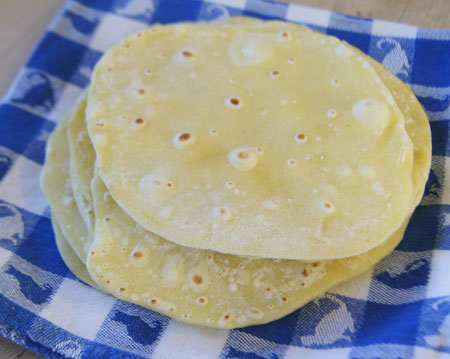 Taste? Not a lot, but I thought they were interesting. They sure are cute.
Taste? Not a lot, but I thought they were interesting. They sure are cute.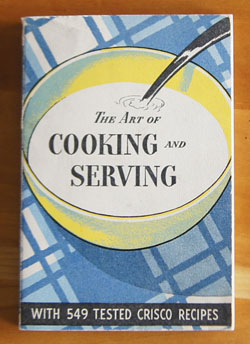
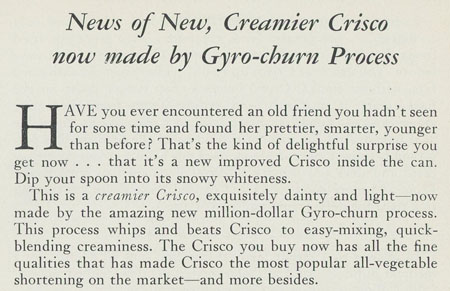 Next come four chapters that discuss the proper way to manage a kitchen and serve food. Transport yourself back 81 years, to the kitchen of my grandmother, to the culture of America in the 1930s. Here is the beginning of the first chapter:
Next come four chapters that discuss the proper way to manage a kitchen and serve food. Transport yourself back 81 years, to the kitchen of my grandmother, to the culture of America in the 1930s. Here is the beginning of the first chapter: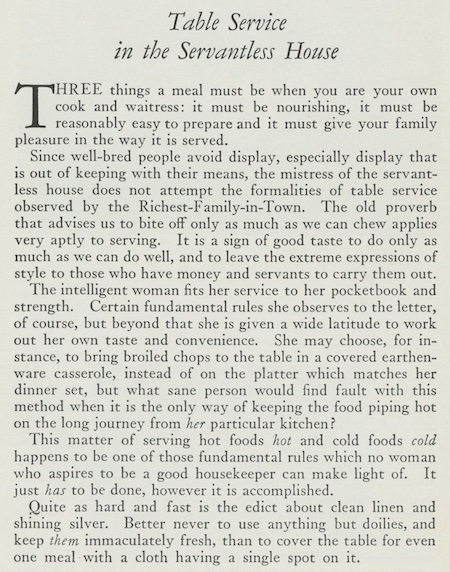
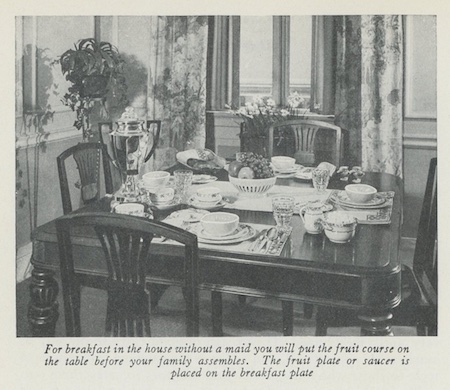 This chapter goes on for 24 pages describing the proper way to serve food in the servantless home. And if you have a maid? That chapter has 9 pages, beginning with these paragraphs:
This chapter goes on for 24 pages describing the proper way to serve food in the servantless home. And if you have a maid? That chapter has 9 pages, beginning with these paragraphs: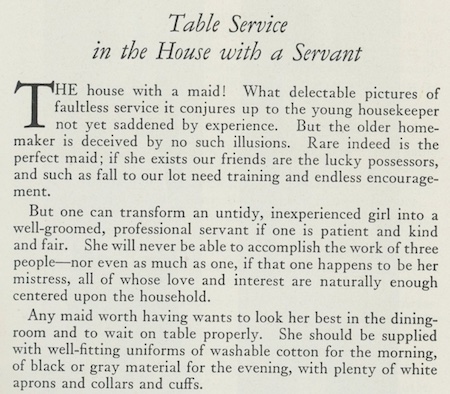
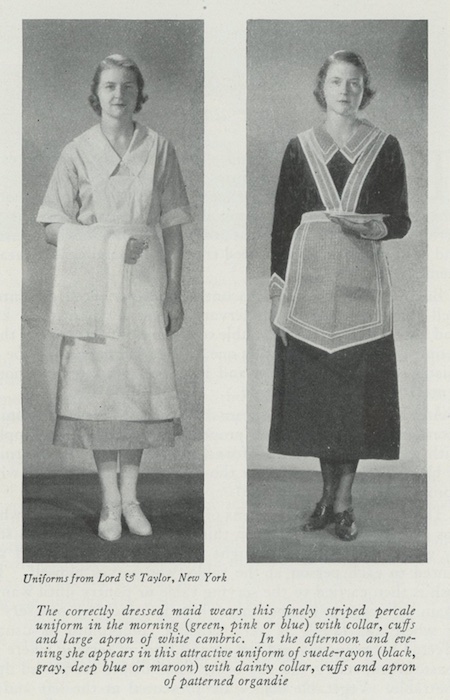
 “How to Plan Your Meals” is a short chapter on what foods to include in your diet for sufficient protein, energy (fats, starches, sugars), body regulation (roughage and minerals), vitamins, and water.
“How to Plan Your Meals” is a short chapter on what foods to include in your diet for sufficient protein, energy (fats, starches, sugars), body regulation (roughage and minerals), vitamins, and water.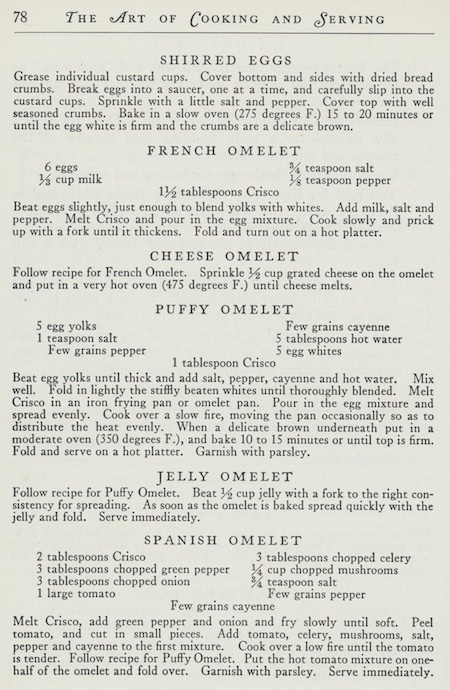 Here is a photo of the omelet:
Here is a photo of the omelet: These recipes are for main dishes.
These recipes are for main dishes.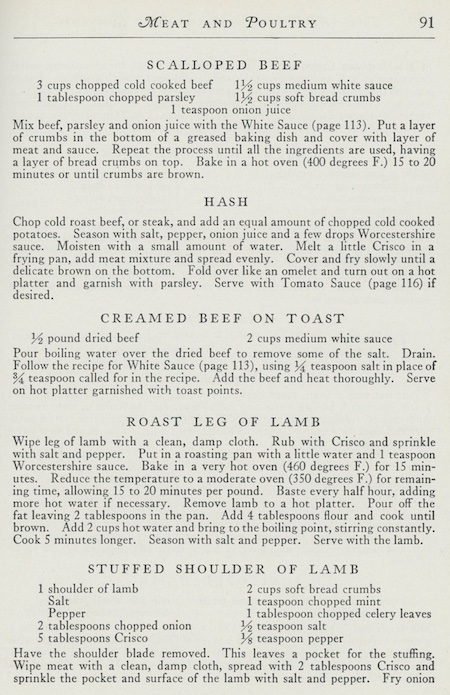 These are classic cookie recipes, especially the Hermits (a dark spice cookie filled with fruits and nuts) and the Oatmeal Cookies.
These are classic cookie recipes, especially the Hermits (a dark spice cookie filled with fruits and nuts) and the Oatmeal Cookies.
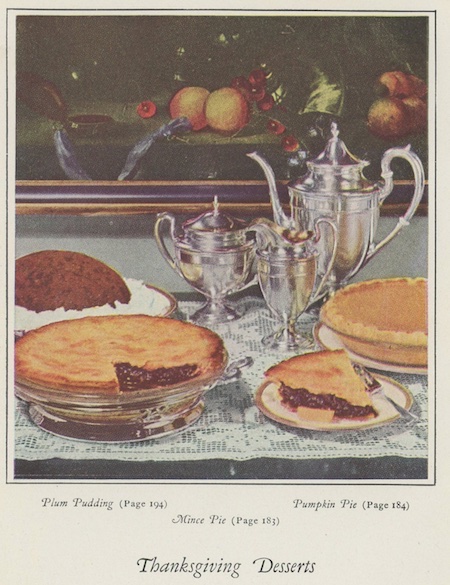
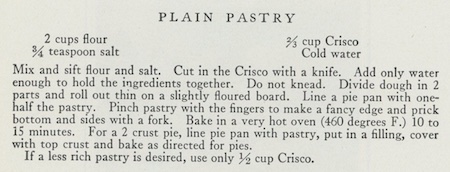 And what type of pie to make with the plain pastry crust? Why not old-fashioned Mincemeat Pie, or Mock Cherry Pie:
And what type of pie to make with the plain pastry crust? Why not old-fashioned Mincemeat Pie, or Mock Cherry Pie: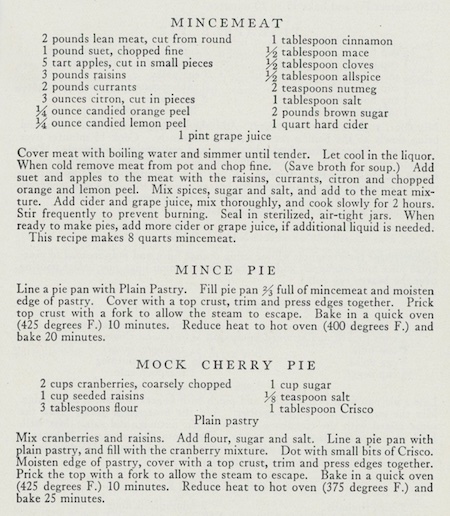
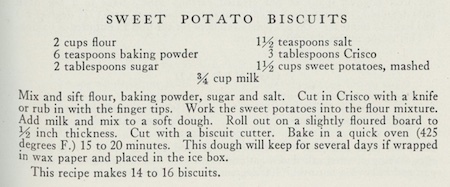 I think this is an amazing recipe. For one, it calls for 1 1/2 cups of sweet potatoes – and that’s a lot! And it calls for only 2 tablespoons of sugar and 3 of shortening. I think the 2 tablespoons baking powder might be a bit much, but I stayed with that original amount. I am going to use my immersion blender to mash the sweet potatoes with the milk, and my food processor for the flour and shortening. Otherwise, I am staying with the original recipe.
I think this is an amazing recipe. For one, it calls for 1 1/2 cups of sweet potatoes – and that’s a lot! And it calls for only 2 tablespoons of sugar and 3 of shortening. I think the 2 tablespoons baking powder might be a bit much, but I stayed with that original amount. I am going to use my immersion blender to mash the sweet potatoes with the milk, and my food processor for the flour and shortening. Otherwise, I am staying with the original recipe.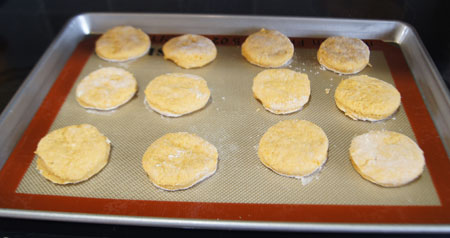 Here they are, baked:
Here they are, baked: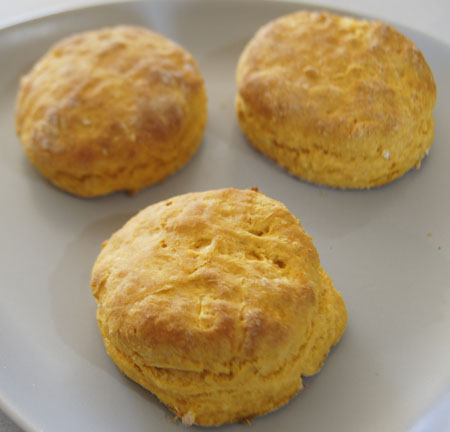
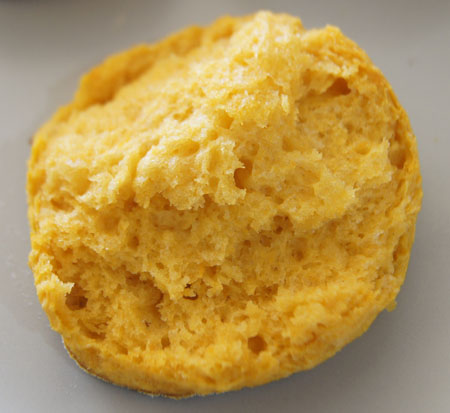 My daughter and I really loved these. Hubby avoided them – he isn’t a sweet potato fan. His loss. And more for us! This was definitely a successful recipe.
My daughter and I really loved these. Hubby avoided them – he isn’t a sweet potato fan. His loss. And more for us! This was definitely a successful recipe.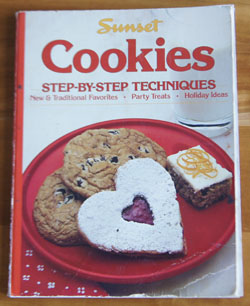 I’ve saved this book for one of my last entries for this 250 Cookbooks blog because it is special to me. It was my mother’s, given to her by my brother and sister in 1986. Her notes are in it, some pages are stained with food, and many pages are falling out of the binding. I just love it!
I’ve saved this book for one of my last entries for this 250 Cookbooks blog because it is special to me. It was my mother’s, given to her by my brother and sister in 1986. Her notes are in it, some pages are stained with food, and many pages are falling out of the binding. I just love it!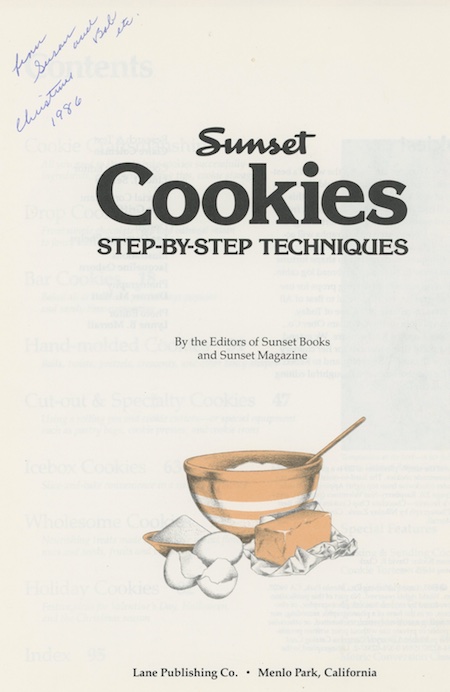
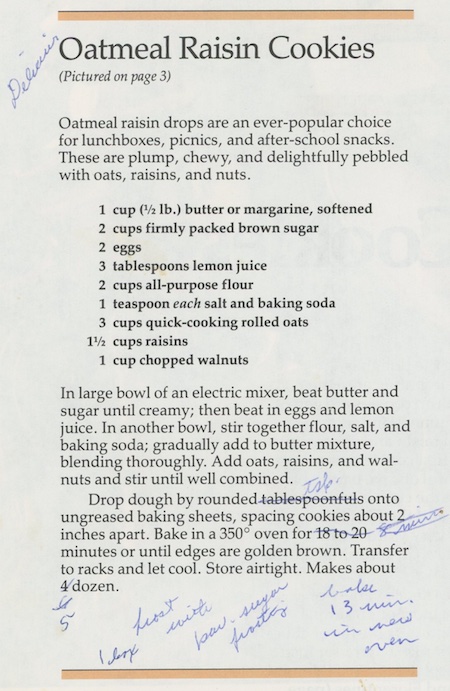
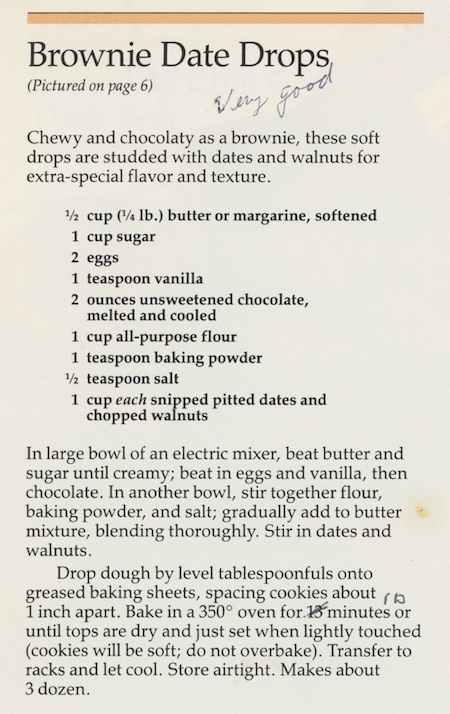
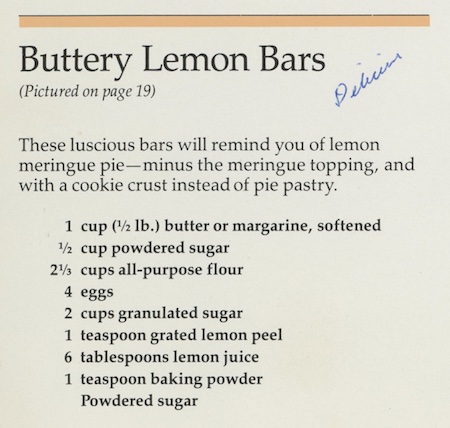

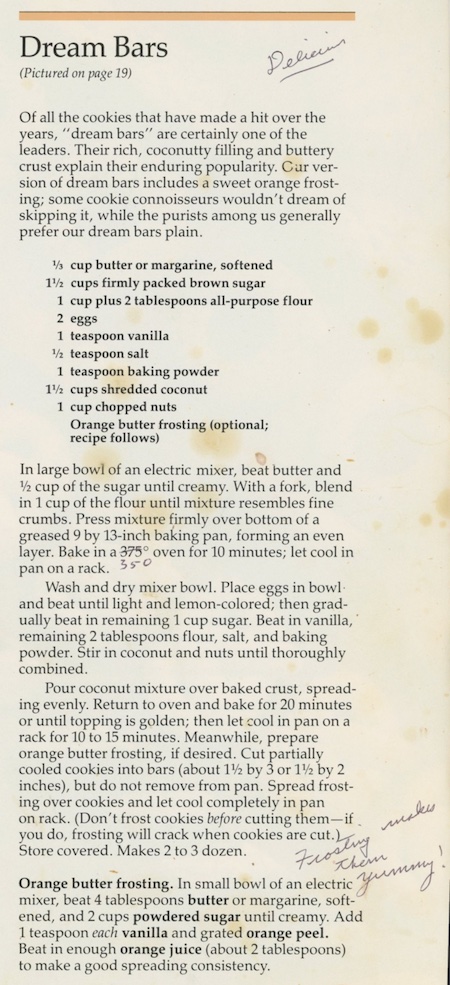
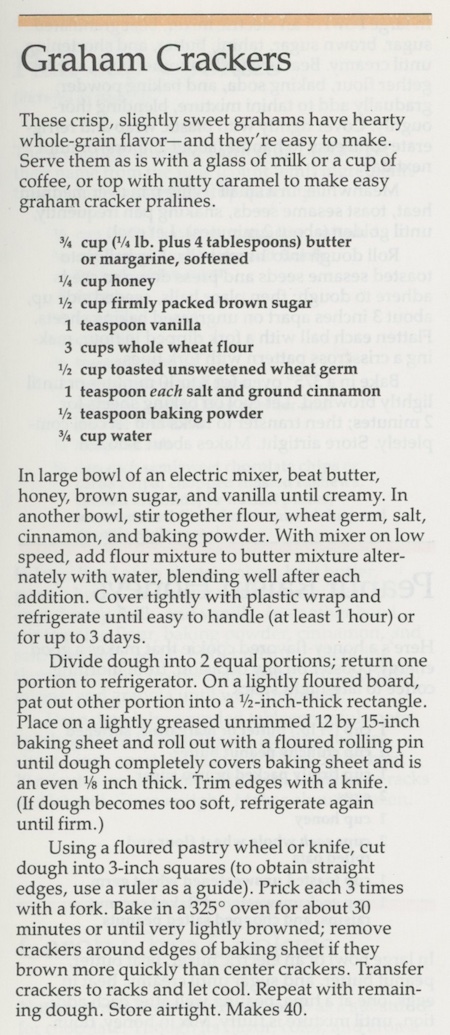
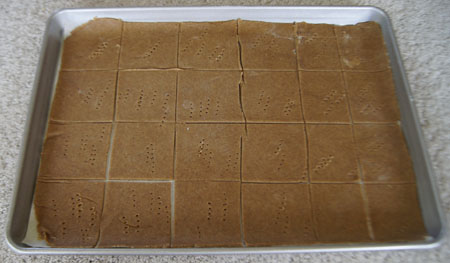 And here is a cooked one on a plate:
And here is a cooked one on a plate: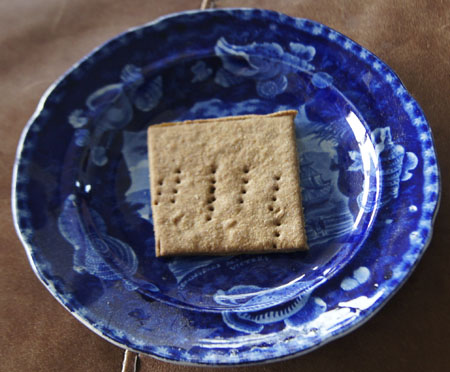 Oh yes, there are not just 3 fork pricks in this cracker! Practicing “one-two-three” with a 4 year old sometimes doesn’t work. But who cares? These were actually delicious, although not all the adults liked them. I thought they were even better the next day, but I doubt the rest of the batch lasted that long – my grandson made sure that he put all his crackers in a bag to take home. I saved this one cracker in the photo above to be sure I had one to take of picture of the next day. Then I ate it!
Oh yes, there are not just 3 fork pricks in this cracker! Practicing “one-two-three” with a 4 year old sometimes doesn’t work. But who cares? These were actually delicious, although not all the adults liked them. I thought they were even better the next day, but I doubt the rest of the batch lasted that long – my grandson made sure that he put all his crackers in a bag to take home. I saved this one cracker in the photo above to be sure I had one to take of picture of the next day. Then I ate it!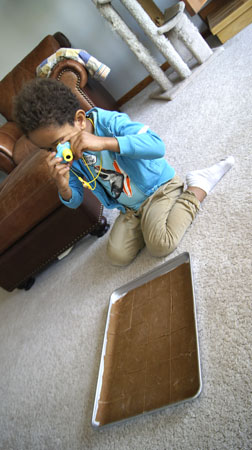
 “I smile warmly at Julia Child’s complete love of cooking”. These words were mine when I explored
“I smile warmly at Julia Child’s complete love of cooking”. These words were mine when I explored  From the above excerpt, we learn that Mastering the Art of French Cooking was written as a textbook, a complete guide, and was written as a collaboration. I used to be a bit intimidated by that first tome. (Now I totally enjoy it!) From Julia Child’s Kitchen is less serious and more fun. Sure, it includes all the important methods of preparing soups, poultry, meats, egg dishes, quiches, homemade sausages, fresh vegetables, French breads, pastries and desserts. But it focuses on the American home cook, with recipes that can be made in a reasonable amount of time and with any level of cooking skill. From Julia Child’s Kitchen also has a chapter on “earthy alternatives”, such as lentils, beans and rice. I find most of the recipes a bit less calorie-laden than in her previous book. And, there are cartoons throughout.
From the above excerpt, we learn that Mastering the Art of French Cooking was written as a textbook, a complete guide, and was written as a collaboration. I used to be a bit intimidated by that first tome. (Now I totally enjoy it!) From Julia Child’s Kitchen is less serious and more fun. Sure, it includes all the important methods of preparing soups, poultry, meats, egg dishes, quiches, homemade sausages, fresh vegetables, French breads, pastries and desserts. But it focuses on the American home cook, with recipes that can be made in a reasonable amount of time and with any level of cooking skill. From Julia Child’s Kitchen also has a chapter on “earthy alternatives”, such as lentils, beans and rice. I find most of the recipes a bit less calorie-laden than in her previous book. And, there are cartoons throughout.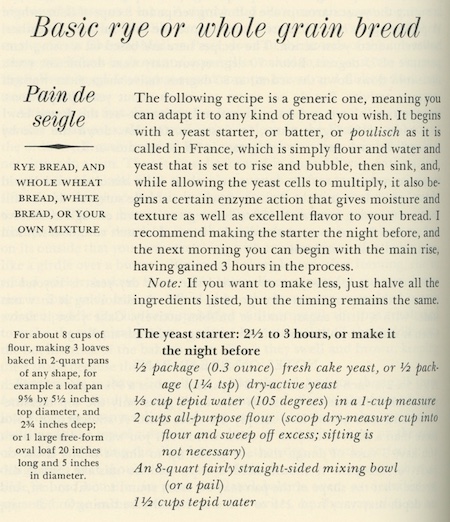
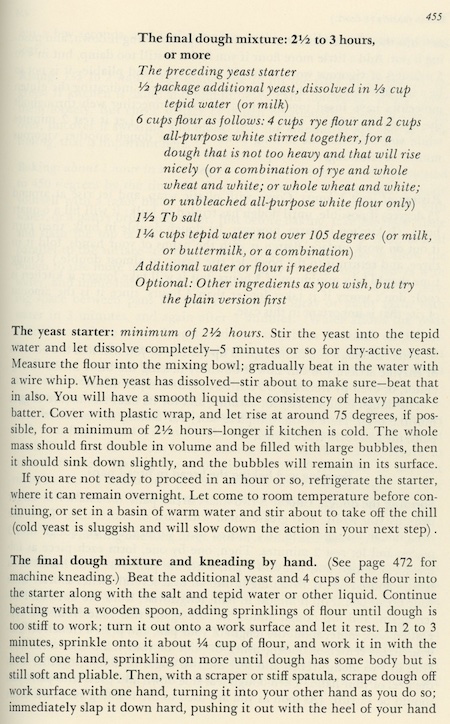

 And in the very back of From Julia Child’s Kitchen I find this – what I call very funny – passage in one of the appendices:
And in the very back of From Julia Child’s Kitchen I find this – what I call very funny – passage in one of the appendices: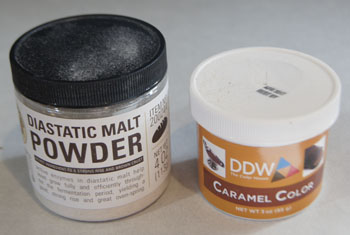
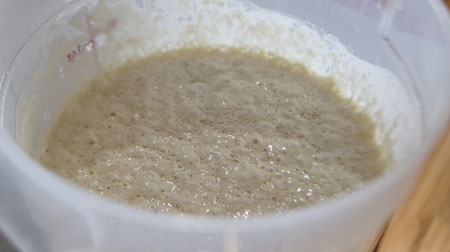 It is just lovely and bubbly and has a wonderful yeasty sour smell.
It is just lovely and bubbly and has a wonderful yeasty sour smell.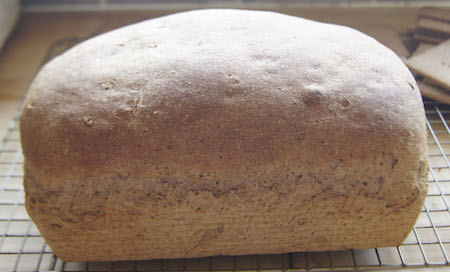

 The Vegetarian Cookbook is pleasantly laid out and illustrated, and Nicola Graimes is a personable author. I probably bought this book at a time when my daughter was vegetarian. I don’t think I’ve cooked many – if any – of the recipes in it! Why not? I really can’t tell you.
The Vegetarian Cookbook is pleasantly laid out and illustrated, and Nicola Graimes is a personable author. I probably bought this book at a time when my daughter was vegetarian. I don’t think I’ve cooked many – if any – of the recipes in it! Why not? I really can’t tell you. (This book is hard to open out flat enough to follow a recipe while cooking!)
(This book is hard to open out flat enough to follow a recipe while cooking!) This bread is excellent! I think I found the perfect combination of whole wheat flours to give it excellent flavor and still have good texture – sometimes whole wheat loaves turn out sort of like heavy rocks. The walnuts made me keep wanting to have another bite! Note that this is a good bread for people on a low-carb diet, because it is whole-grain and also has nuts.
This bread is excellent! I think I found the perfect combination of whole wheat flours to give it excellent flavor and still have good texture – sometimes whole wheat loaves turn out sort of like heavy rocks. The walnuts made me keep wanting to have another bite! Note that this is a good bread for people on a low-carb diet, because it is whole-grain and also has nuts. 1938. It’s amazing this vintage cookbook has lasted this long! One tear in the front cover is the only flaw. I open to the first page:
1938. It’s amazing this vintage cookbook has lasted this long! One tear in the front cover is the only flaw. I open to the first page: “How to have success with chocolate” is the second page:
“How to have success with chocolate” is the second page: “For over150 years Baker’s has set the standards for fine chocolate”. Since this book was published in 1938, that means Baker’s Chocolate was formed in 1788 or earlier. Let’s check. I pull up Wikipedia’s entry for
“For over150 years Baker’s has set the standards for fine chocolate”. Since this book was published in 1938, that means Baker’s Chocolate was formed in 1788 or earlier. Let’s check. I pull up Wikipedia’s entry for  From the above label, we can see that one-half an ounce of baking chocolate has 90 calories, 78% from from fat, with a small amount of dietary fiber and 2 grams of protein. No vitamin A or C, no calcium, but some iron. Valuable food elements, yes, I guess. But nowadays – unlike 1938 – chocolate, especially dark chocolate, has been found to be chock-full of trace nutrients and antioxidants and more, as in this article on
From the above label, we can see that one-half an ounce of baking chocolate has 90 calories, 78% from from fat, with a small amount of dietary fiber and 2 grams of protein. No vitamin A or C, no calcium, but some iron. Valuable food elements, yes, I guess. But nowadays – unlike 1938 – chocolate, especially dark chocolate, has been found to be chock-full of trace nutrients and antioxidants and more, as in this article on 



 Here’s my helper, doing the stirring chores!
Here’s my helper, doing the stirring chores! Later, after dinner, we enjoyed the sauce over vanilla ice cream and berries.
Later, after dinner, we enjoyed the sauce over vanilla ice cream and berries. Yum yum yum! It was pretty special to have our own homemade sauce.
Yum yum yum! It was pretty special to have our own homemade sauce.


 This is my current crock pot. It replaced a nearly-broken one in about 2006. This one has a removable stoneware crock that makes it easy to clean, a high-low setting, and a timer. This is my first crock pot with a timer, and I’d always get one like this from now on.
This is my current crock pot. It replaced a nearly-broken one in about 2006. This one has a removable stoneware crock that makes it easy to clean, a high-low setting, and a timer. This is my first crock pot with a timer, and I’d always get one like this from now on.
 My version is below. I added more stock and more wine, and found that these changes gave just the right amount and thickness of gravy at the end. I used double the amount of tomato paste. I did not add the 3 tablespoons butter plus 3 tablespoons flour at the very end to thicken the broth, but I suggest you do that if you want a really thick gravy.
My version is below. I added more stock and more wine, and found that these changes gave just the right amount and thickness of gravy at the end. I used double the amount of tomato paste. I did not add the 3 tablespoons butter plus 3 tablespoons flour at the very end to thicken the broth, but I suggest you do that if you want a really thick gravy. This was totally yummy. I loved the rich, dark broth-gravy. I am glad I didn’t add the flour/butter mixture at the end to thicken the gravy. It was rich and thick enough for me as it was – it was indeed “especially tasty”. I’m also glad I added more wine than called for in the recipe. I liked the sautéd mushrooms added for the last hour – their texture and flavor were not lost by 8 hours of cooking.
This was totally yummy. I loved the rich, dark broth-gravy. I am glad I didn’t add the flour/butter mixture at the end to thicken the gravy. It was rich and thick enough for me as it was – it was indeed “especially tasty”. I’m also glad I added more wine than called for in the recipe. I liked the sautéd mushrooms added for the last hour – their texture and flavor were not lost by 8 hours of cooking.